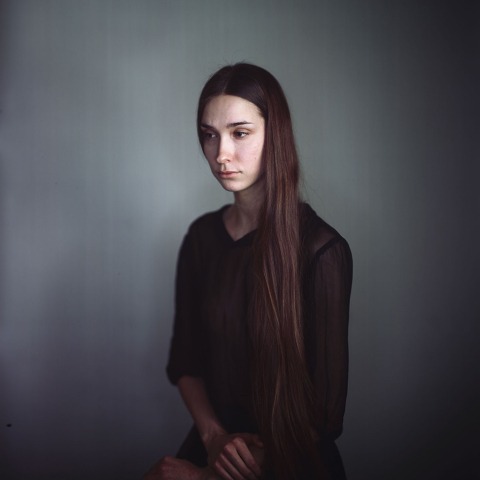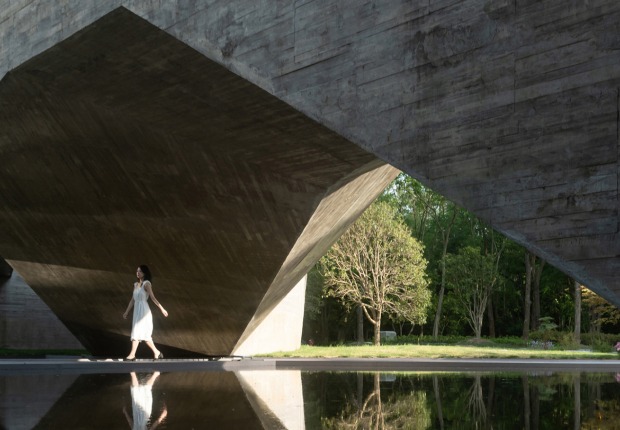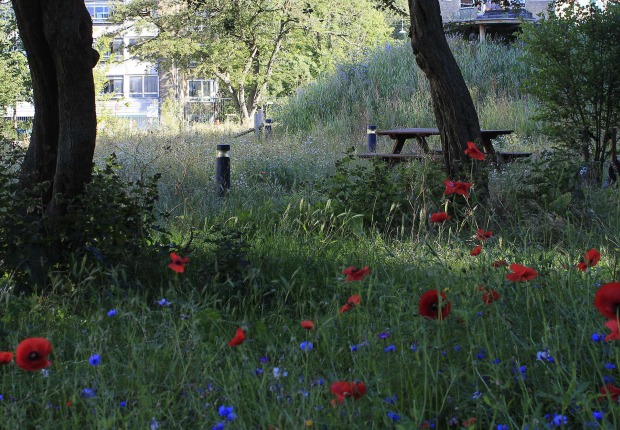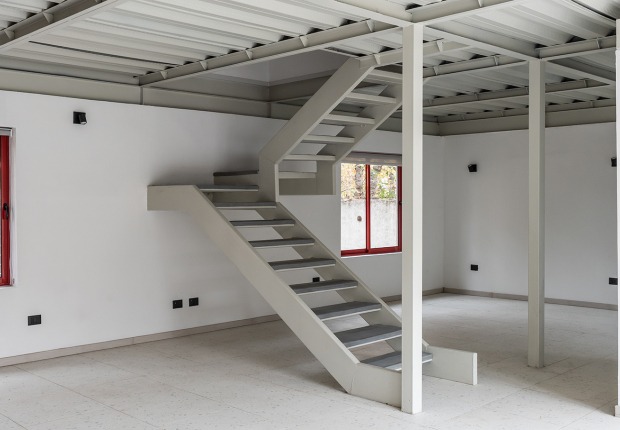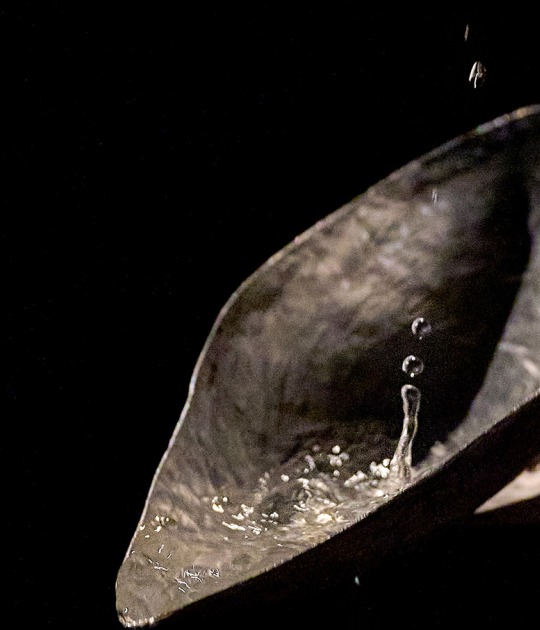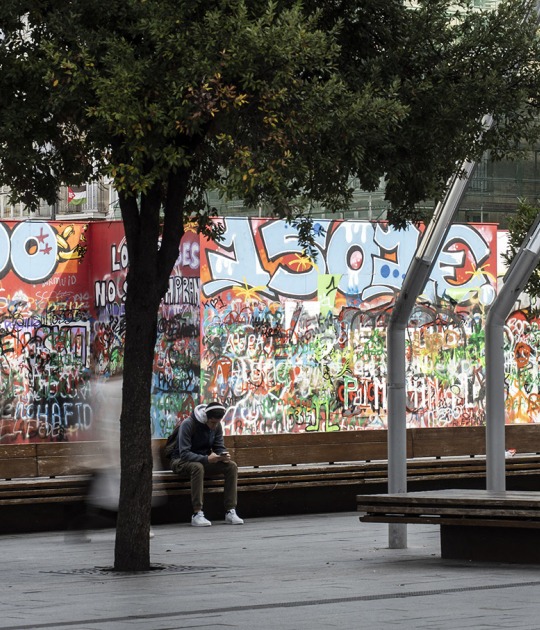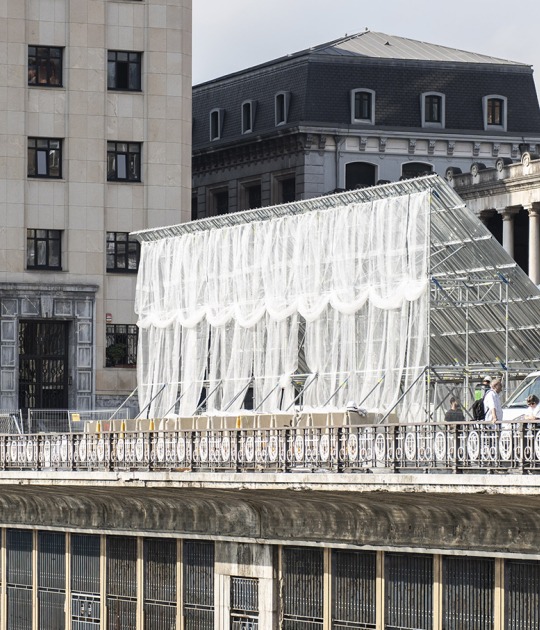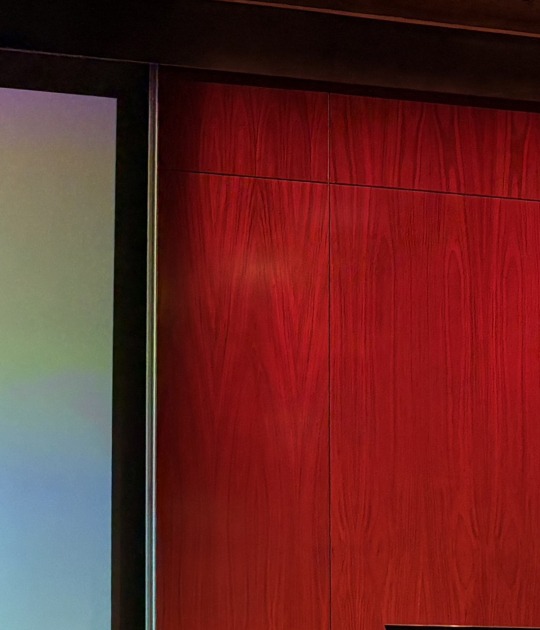Richard Learoyd has been recognized for the unique photographic works he has done for more than a decade and which consist mainly of portraits of dressed or nude models made in his studio, but he has also addressed other themes: animal photography, landscapes or dark mirrors. All of them receive the same serious and tender attention. Many of the animals are no longer alive, they are wrapped in wires or strained by threads to be examined. They are not the material of a common still life, but rather experiments, often playful and prolonged with ordinary and sometimes uncommon objects.
The mirrors are perhaps the most abstract: they look like constellations of deep outer space. Recently, he has taken large-scale photographs in black and white, and has even taken his huge camera outside to photograph landscapes and old buildings found in small cities in Eastern Europe. In some cases, he returns to the same place to photograph it in different seasons of the year.
This exhibition presents Richard Learoyd at the height of his career, with a selection of 51 works in color and black and white that summarizes the best of his work over the course of a decade. The exhibition also includes one of the landscapes made in Spain (in Lanzarote), the result of a commission from Fundación MAPFRE and incorporated into the Foundation's Photography Collection, which already has two other works by the artist.
His work has recently been exhibited at the Victoria & Albert Museum in London (2015) and at the J. Paul Getty Museum in Los Angeles (2016). His photographs are in collections of the world's leading museums, including the Metropolitan Museum of Art in New York, the Center Pompidou in Paris, the Victoria & Albert Museum and the Tate in London, the San Francisco Museum of Modern Art, the Nelson-Atkins Museum of Art in Kansas City (Missouri) or the National Gallery of Canada in Ottawa, as well as other important institutions and numerous private collections.
Richard Learoyd was represented by the McKee Gallery in New York until its closure in 2016. He is currently represented by the Fraenkel Gallery in San Francisco and the Pace/MacGill Gallery in New York. The exhibition can be seen in the Fundación MAPFRE rooms in Barcelona and Madrid and will also travel to the Fotomuseum Den Haag in The Hague.
THE EXHIBITION
The route proposed in the exhibition is more thematic than chronological, combining landscapes, portraits and still lifes on the walls of its rooms.
PHOTOGRAPHS OF THE CAMERA OBSCURA
The English artist Richard Learoyd has been taking photographs with his camera obscura for approximately twenty years. It is a large studio camera of his own design based on old optical principles. This instrument has allowed him to take photographs that possess a captivating singularity at a time when photography is trivial and abundant.
The people who appear in his images seem to inhabit a world of a particular psychological intensity and are examined in an extraordinarily crystalline and distinctive light. Even the subjects - sometimes quite unusual ones- that he chooses for his still lifes possess an exceptional, evocative beauty and quietness.
The photographs he takes with this instrument are basically as big as the camera itself. Both taking and observing these photographs requires a more careful and attentive way of looking, an activity more contemplative than the immediacy with which we usually see and photograph the world. Learoyd has developed this camera of great proportions, and at the same time quite flexible, so that it is mobile in spite of certain limitations.
After composing the image, place on the back of the camera a sheet of photographic paper, the size of his machine, and creates a single copy. Despite its complexity, this technology allows him to perform very characteristic works that have an unusual quality of light and color. In these photographs there is nothing fortuitous.
More recently, the photographer has expanded his technological horizon and has designed a camera that can be taken outside to make a limited number of non-unique prints. Again, they have nothing to do with any other photograph we have seen before and focus on a generous variety of themes. Free in the outside world, Learoyd has photographed well-known places, such as the Yosemite Valley in California, and also less familiar territories in Eastern Europe.
These new images seem to examine the situation of the modern world, ravishingly beautiful and at the same time potentially destructive. They represent a release from the above limitations imposed by their self-defined process and are only the beginning of a new vision of a wider world.
NEW IMAGES
Before experimenting with the magical color images for which he is so well known today, Learoyd was a landscape photographer who took classic black and white photographs. Recently he has been able to modify his large camera obscura to take it outside and this change has allowed him to produce images that contain the emotion of discovery.
While working to refine his process, the images became increasingly complex. His first experimental works in black and white were very similar to the photographs he made in color: for example, the portraits of Agnes nude and the group of magpies trapped in threads. These photographs were produced in the studio. When he moved abroad he discovered a discreet and mysterious bag with fishing nets on a beach in Portugal (The Sins of the Father); and also devised a family portrait in front of a manor house (The Von der Becke family), a more ambitious image in terms of composition.
Lately it has gone even further: to a desert lunar landscape on the island of Lanzarote and even the hybrid architectural forms in Eastern Europe (Gdansk, Poland). He also collects burned cars in the United States, which he keeps in a warehouse in Texas to photograph their carcasses as metaphors of the disturbing present, specimens of some kind of holocaust.
PORTRAITS AND FIGURES
Although the people we see in Learoyd's studio photographs seem very contemporary, as if they had just sat there a moment ago and were waiting for him to finish adjusting his curious and voluminous camera, these figures also possess a timeless quality reminiscent of art from the past. Since ancient times, visual expression has been dominated by both the portrait and the painting of figures. In museums around the world we find images of people dressed, naked or sitting patiently while an artist describes the elaborate embroidery of a dress or the particular complexion of a beautiful young woman.
Besides looking at the great artists of the Renaissance, Learoyd has studied nineteenth-century painters, such as Jean-Auguste-Dominique Ingres, a particularly elegant portrait artist. Ingres was also a great master of nude portraits and some of the paintings he created resonate in the images of the photographer's figures. Also, despite the fact that Learoyd's photographs establish a dialogue with the works of the English pre-Raphaelite painters, it is the Victorian photographer Julia Margaret Cameron who has a singular importance for him.
But as relevant as these artistic precursors is the distinctive personality of Learoyd, which transforms what he chooses to photograph with his particular form of perception. Learoyd's figure studies and his portraits are especially aligned with the present: the sensation of distance, the internalized emotions and the strange beauty of the bodies are testimonies of a present full of restlessness.
STILL LIFES [LIVES DETAINED]
Learoyd has been particularly interested in the creation of still lifes, although his are substantially different from many of the classical expressions of this genre in the history of art. In the Netherlands, seventeenth-century still-life paintings were often a display of luxury objects and many included symbols of the passage of time, like extravagant bouquets of flowers with hidden insects.
The works of the famous French painter of the 18th century Jean Siméon Chardin valued the simple pleasures of a modest life: freshly picked cherries on a plate or a bread on a table represented with precision and exquisiteness. Later painters, from impressionism onward, have also arranged objects in their studios to analyze them: Paul Cézanne and his modern followers liked to distribute apples on the table. Traditionally, still lifes have emotionally demanded little from their viewers.
Learoyd has rethought the "still life" giving special emphasis to the meaning of the term: these are photographs of lives that have been stopped. Some are similar to images that we are already familiar with: the ripped branch with wild apples, for example, here seems unusually loaded and fortuitous, as if it had just been taken from a garden to be photographed in an interior.
Others are both beautiful and disquieting: a sectioned horse head, with its shiny white hair and its shiny, dark eye in clear contrast to the deep red blood of the neck. Learoyd has also arranged magpies and swans as hanging decorations; presented in a fantastic way, but dead. Some of his most original images are hybrid shapes that he has sculpted with beings that were once alive: Fish heart I, for example, is formed by two organisms sewn together and suspended in the air.
EXHIBITION CATALOG
The catalog that accompanies the exhibition features texts by Philip Gefter, writer and photography critic of The New York Times, and its curator, Sandra S. Phillips, curator emeritus of photography at the San Francisco Museum of Modern Art.
The book has a version in Catalan and another in Spanish published by Fundación MAPFRE, as well as an English version co-edited by Fundación MAPFRE and the Fraenkel Gallery of San Francisco.
INDIVIDUAL EXHIBITIONS AND PUBLICATIONS
2007 - Twenty Two Photographs, Union Gallery, London (November 18, 2007 - March 2, 2008). Catalog of the exhibition with texts by Christopher Bucklow and Martin Barnes: Richard Learoyd. Twenty Two Photographs, 2005-07 (self-edition of the artist), 2008.
2009 - Unique Photographs, McKee Gallery, New York (September 24-October 31, 2009). Catalog of the exhibition with Christopher Bucklow interview: Richard Learoyd. Unique Photographs, 2007-09.
2011 - Presences, Fraenkel Gallery, San Francisco (May 5-June 25, 2011). Catalog of the exhibition.
Portraits and Figures, McKee Gallery, New York (September 28-October 29, 2011). Catalog of the exhibition with text by Mark Alice Durant.
2013 - Still / Life, McKee Gallery, New York (May 9-June 30, 2013). Catalog of the exhibition with text by Charles Moffet.
The Outside World, Fraenkel Gallery, San Francisco (September 12-October 26, 2013).
2015 - Dark Mirror, Victoria & Albert Museum, London (October 24, 2015 - February 14, 2016).
2016 - Day for Night, Pace/MacGill Gallery, New York (1-30 April 2016). Catalog of the exhibition with texts by Martin Barnes, Nancy Gryspeerdt and Richard Learoyd: Richard Learoyd: Day for Night, Aperture Foundation and Pier 24 Photography, New York and San Francisco, 2015.
In the Studio, J. Paul Getty Museum, Los Angeles (August 30-November 27, 2016), and Nelson-Atkins Museum of Art, Kansas City (February 10-June 11, 2017).
2017 - Richard Learoyd, Fraenkel Gallery, San Francisco (January 5-March 4, 2017).
2018 - Work from Two Rooms, Fraenkel Gallery, San Francisco (October 25-December 22, 2018).
2019 - Richard Learoyd, Pace / MacGill Gallery, New York (April 3-May 11, 2019).
Richard Learoyd, Fundación MAPFRE, Casa Garriga Nogués, Barcelona (June 5-September 8, 2019), Fotomuseum Den Haag, The Hague (October 5, 2019-January 5, 2020), and Fundación MAPFRE, Madrid (19 February-May 24, 2020). Catalog of the exhibition with texts by Sandra S. Phillips and Philip Gefter: Fundación MAPFRE (Spanish and Catalan) and Fundación MAPFRE with Fraenkel Gallery (English), Madrid, 2019.
PUBLIC COLLECTIONS (SELECTION)
Albright-Knox Art Gallery, Buffalo, New York. Center Pompidou, Paris. MAPFRE Foundation, Madrid.
Middlebury College Museum of Art, Middlebury, Vermont. National Gallery of Canada, Ottawa, Ontario. Pier 24 Photography, San Francisco, California. San Francisco Museum of Modern Art, San Francisco, California. Scottish Arts Council, Edinburgh, Scotland.
Tate, London The J. Paul Getty Museum, Los Angeles, California. The JP Morgan Chase Art Collection, New York. The Metropolitan Museum of Art, New York. The Museum of Fine Arts, Houston, Texas. The Museum of Modern Art, New York. The Nelson-Atkins Museum of Art, Kansas City, Missouri. The Victoria & Albert Museum, London. Wilson Center for Photography, London. Yale University Art Gallery, New Haven, Connecticut.
The mirrors are perhaps the most abstract: they look like constellations of deep outer space. Recently, he has taken large-scale photographs in black and white, and has even taken his huge camera outside to photograph landscapes and old buildings found in small cities in Eastern Europe. In some cases, he returns to the same place to photograph it in different seasons of the year.
This exhibition presents Richard Learoyd at the height of his career, with a selection of 51 works in color and black and white that summarizes the best of his work over the course of a decade. The exhibition also includes one of the landscapes made in Spain (in Lanzarote), the result of a commission from Fundación MAPFRE and incorporated into the Foundation's Photography Collection, which already has two other works by the artist.
His work has recently been exhibited at the Victoria & Albert Museum in London (2015) and at the J. Paul Getty Museum in Los Angeles (2016). His photographs are in collections of the world's leading museums, including the Metropolitan Museum of Art in New York, the Center Pompidou in Paris, the Victoria & Albert Museum and the Tate in London, the San Francisco Museum of Modern Art, the Nelson-Atkins Museum of Art in Kansas City (Missouri) or the National Gallery of Canada in Ottawa, as well as other important institutions and numerous private collections.
Richard Learoyd was represented by the McKee Gallery in New York until its closure in 2016. He is currently represented by the Fraenkel Gallery in San Francisco and the Pace/MacGill Gallery in New York. The exhibition can be seen in the Fundación MAPFRE rooms in Barcelona and Madrid and will also travel to the Fotomuseum Den Haag in The Hague.
THE EXHIBITION
The route proposed in the exhibition is more thematic than chronological, combining landscapes, portraits and still lifes on the walls of its rooms.
PHOTOGRAPHS OF THE CAMERA OBSCURA
The English artist Richard Learoyd has been taking photographs with his camera obscura for approximately twenty years. It is a large studio camera of his own design based on old optical principles. This instrument has allowed him to take photographs that possess a captivating singularity at a time when photography is trivial and abundant.
The people who appear in his images seem to inhabit a world of a particular psychological intensity and are examined in an extraordinarily crystalline and distinctive light. Even the subjects - sometimes quite unusual ones- that he chooses for his still lifes possess an exceptional, evocative beauty and quietness.
The photographs he takes with this instrument are basically as big as the camera itself. Both taking and observing these photographs requires a more careful and attentive way of looking, an activity more contemplative than the immediacy with which we usually see and photograph the world. Learoyd has developed this camera of great proportions, and at the same time quite flexible, so that it is mobile in spite of certain limitations.
After composing the image, place on the back of the camera a sheet of photographic paper, the size of his machine, and creates a single copy. Despite its complexity, this technology allows him to perform very characteristic works that have an unusual quality of light and color. In these photographs there is nothing fortuitous.
More recently, the photographer has expanded his technological horizon and has designed a camera that can be taken outside to make a limited number of non-unique prints. Again, they have nothing to do with any other photograph we have seen before and focus on a generous variety of themes. Free in the outside world, Learoyd has photographed well-known places, such as the Yosemite Valley in California, and also less familiar territories in Eastern Europe.
These new images seem to examine the situation of the modern world, ravishingly beautiful and at the same time potentially destructive. They represent a release from the above limitations imposed by their self-defined process and are only the beginning of a new vision of a wider world.
NEW IMAGES
Before experimenting with the magical color images for which he is so well known today, Learoyd was a landscape photographer who took classic black and white photographs. Recently he has been able to modify his large camera obscura to take it outside and this change has allowed him to produce images that contain the emotion of discovery.
While working to refine his process, the images became increasingly complex. His first experimental works in black and white were very similar to the photographs he made in color: for example, the portraits of Agnes nude and the group of magpies trapped in threads. These photographs were produced in the studio. When he moved abroad he discovered a discreet and mysterious bag with fishing nets on a beach in Portugal (The Sins of the Father); and also devised a family portrait in front of a manor house (The Von der Becke family), a more ambitious image in terms of composition.
Lately it has gone even further: to a desert lunar landscape on the island of Lanzarote and even the hybrid architectural forms in Eastern Europe (Gdansk, Poland). He also collects burned cars in the United States, which he keeps in a warehouse in Texas to photograph their carcasses as metaphors of the disturbing present, specimens of some kind of holocaust.
PORTRAITS AND FIGURES
Although the people we see in Learoyd's studio photographs seem very contemporary, as if they had just sat there a moment ago and were waiting for him to finish adjusting his curious and voluminous camera, these figures also possess a timeless quality reminiscent of art from the past. Since ancient times, visual expression has been dominated by both the portrait and the painting of figures. In museums around the world we find images of people dressed, naked or sitting patiently while an artist describes the elaborate embroidery of a dress or the particular complexion of a beautiful young woman.
Besides looking at the great artists of the Renaissance, Learoyd has studied nineteenth-century painters, such as Jean-Auguste-Dominique Ingres, a particularly elegant portrait artist. Ingres was also a great master of nude portraits and some of the paintings he created resonate in the images of the photographer's figures. Also, despite the fact that Learoyd's photographs establish a dialogue with the works of the English pre-Raphaelite painters, it is the Victorian photographer Julia Margaret Cameron who has a singular importance for him.
But as relevant as these artistic precursors is the distinctive personality of Learoyd, which transforms what he chooses to photograph with his particular form of perception. Learoyd's figure studies and his portraits are especially aligned with the present: the sensation of distance, the internalized emotions and the strange beauty of the bodies are testimonies of a present full of restlessness.
STILL LIFES [LIVES DETAINED]
Learoyd has been particularly interested in the creation of still lifes, although his are substantially different from many of the classical expressions of this genre in the history of art. In the Netherlands, seventeenth-century still-life paintings were often a display of luxury objects and many included symbols of the passage of time, like extravagant bouquets of flowers with hidden insects.
The works of the famous French painter of the 18th century Jean Siméon Chardin valued the simple pleasures of a modest life: freshly picked cherries on a plate or a bread on a table represented with precision and exquisiteness. Later painters, from impressionism onward, have also arranged objects in their studios to analyze them: Paul Cézanne and his modern followers liked to distribute apples on the table. Traditionally, still lifes have emotionally demanded little from their viewers.
Learoyd has rethought the "still life" giving special emphasis to the meaning of the term: these are photographs of lives that have been stopped. Some are similar to images that we are already familiar with: the ripped branch with wild apples, for example, here seems unusually loaded and fortuitous, as if it had just been taken from a garden to be photographed in an interior.
Others are both beautiful and disquieting: a sectioned horse head, with its shiny white hair and its shiny, dark eye in clear contrast to the deep red blood of the neck. Learoyd has also arranged magpies and swans as hanging decorations; presented in a fantastic way, but dead. Some of his most original images are hybrid shapes that he has sculpted with beings that were once alive: Fish heart I, for example, is formed by two organisms sewn together and suspended in the air.
EXHIBITION CATALOG
The catalog that accompanies the exhibition features texts by Philip Gefter, writer and photography critic of The New York Times, and its curator, Sandra S. Phillips, curator emeritus of photography at the San Francisco Museum of Modern Art.
The book has a version in Catalan and another in Spanish published by Fundación MAPFRE, as well as an English version co-edited by Fundación MAPFRE and the Fraenkel Gallery of San Francisco.
INDIVIDUAL EXHIBITIONS AND PUBLICATIONS
2007 - Twenty Two Photographs, Union Gallery, London (November 18, 2007 - March 2, 2008). Catalog of the exhibition with texts by Christopher Bucklow and Martin Barnes: Richard Learoyd. Twenty Two Photographs, 2005-07 (self-edition of the artist), 2008.
2009 - Unique Photographs, McKee Gallery, New York (September 24-October 31, 2009). Catalog of the exhibition with Christopher Bucklow interview: Richard Learoyd. Unique Photographs, 2007-09.
2011 - Presences, Fraenkel Gallery, San Francisco (May 5-June 25, 2011). Catalog of the exhibition.
Portraits and Figures, McKee Gallery, New York (September 28-October 29, 2011). Catalog of the exhibition with text by Mark Alice Durant.
2013 - Still / Life, McKee Gallery, New York (May 9-June 30, 2013). Catalog of the exhibition with text by Charles Moffet.
The Outside World, Fraenkel Gallery, San Francisco (September 12-October 26, 2013).
2015 - Dark Mirror, Victoria & Albert Museum, London (October 24, 2015 - February 14, 2016).
2016 - Day for Night, Pace/MacGill Gallery, New York (1-30 April 2016). Catalog of the exhibition with texts by Martin Barnes, Nancy Gryspeerdt and Richard Learoyd: Richard Learoyd: Day for Night, Aperture Foundation and Pier 24 Photography, New York and San Francisco, 2015.
In the Studio, J. Paul Getty Museum, Los Angeles (August 30-November 27, 2016), and Nelson-Atkins Museum of Art, Kansas City (February 10-June 11, 2017).
2017 - Richard Learoyd, Fraenkel Gallery, San Francisco (January 5-March 4, 2017).
2018 - Work from Two Rooms, Fraenkel Gallery, San Francisco (October 25-December 22, 2018).
2019 - Richard Learoyd, Pace / MacGill Gallery, New York (April 3-May 11, 2019).
Richard Learoyd, Fundación MAPFRE, Casa Garriga Nogués, Barcelona (June 5-September 8, 2019), Fotomuseum Den Haag, The Hague (October 5, 2019-January 5, 2020), and Fundación MAPFRE, Madrid (19 February-May 24, 2020). Catalog of the exhibition with texts by Sandra S. Phillips and Philip Gefter: Fundación MAPFRE (Spanish and Catalan) and Fundación MAPFRE with Fraenkel Gallery (English), Madrid, 2019.
PUBLIC COLLECTIONS (SELECTION)
Albright-Knox Art Gallery, Buffalo, New York. Center Pompidou, Paris. MAPFRE Foundation, Madrid.
Middlebury College Museum of Art, Middlebury, Vermont. National Gallery of Canada, Ottawa, Ontario. Pier 24 Photography, San Francisco, California. San Francisco Museum of Modern Art, San Francisco, California. Scottish Arts Council, Edinburgh, Scotland.
Tate, London The J. Paul Getty Museum, Los Angeles, California. The JP Morgan Chase Art Collection, New York. The Metropolitan Museum of Art, New York. The Museum of Fine Arts, Houston, Texas. The Museum of Modern Art, New York. The Nelson-Atkins Museum of Art, Kansas City, Missouri. The Victoria & Albert Museum, London. Wilson Center for Photography, London. Yale University Art Gallery, New Haven, Connecticut.
